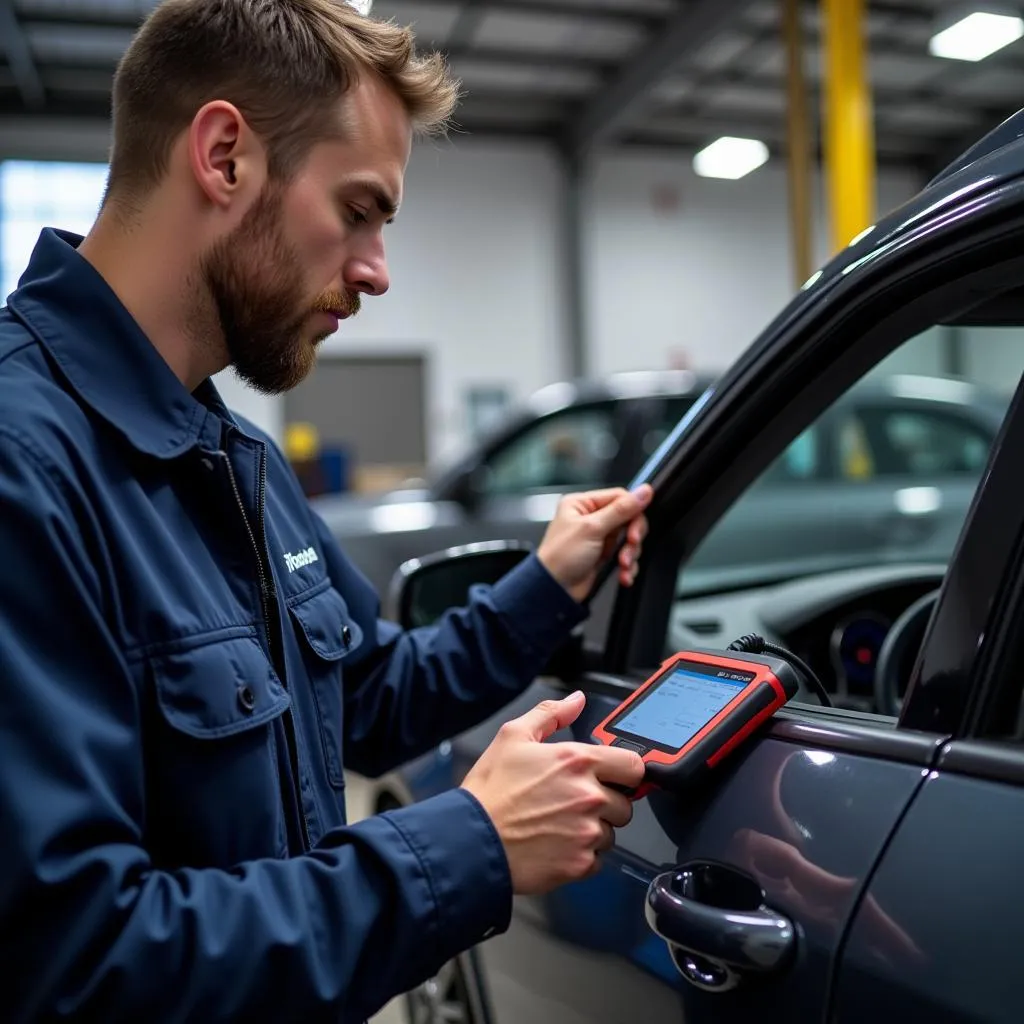Modern vehicles are complex machines that rely on a network of sensors and electronic control units (ECUs) to function correctly. When issues arise, pinpointing the source of the problem can be challenging without the right tools. This is where a bidirectional scan tool comes in, offering a level of diagnostic capability that traditional OBD2 scanners can’t match.
 Bidirectional scan tool connected to a car's OBD2 port
Bidirectional scan tool connected to a car's OBD2 port
What is a Bidirectional Scan Tool?
A bidirectional scan tool, also known as a professional-grade scan tool or J2534 pass-through device, is an advanced diagnostic tool that not only reads but also interacts with a vehicle’s ECUs. Unlike basic OBD2 scanners that primarily display diagnostic trouble codes (DTCs), a bidirectional scan tool allows mechanics and experienced DIYers to:
- Read and clear DTCs: Just like basic scanners, bidirectional tools access and erase fault codes stored in the vehicle’s computer.
- View live data streams: Monitor real-time sensor readings, such as engine RPM, coolant temperature, and oxygen sensor voltage, to identify anomalies.
- Perform active tests: This is the key differentiator. Bidirectional scan tools can command specific components to activate, such as turning on the fuel pump, cycling ABS solenoids, or opening and closing EGR valves, aiding in component isolation and troubleshooting.
- Program and code modules: Some advanced bidirectional scan tools offer module programming capabilities, allowing users to update software, configure replacement modules, and potentially perform key programming functions.
Why Choose a Bidirectional Scan Tool?
 Mechanic using bidirectional scan tool to diagnose car problem
Mechanic using bidirectional scan tool to diagnose car problem
For car enthusiasts and professional mechanics alike, a bidirectional scan tool offers numerous advantages:
- Accurate and Efficient Diagnostics: Quickly identify the root cause of issues with active testing, eliminating guesswork and saving valuable time and money on unnecessary repairs.
- Comprehensive Vehicle Coverage: High-quality bidirectional scanners support a wide range of vehicle makes, models, and systems, offering versatility for diverse repair needs.
- Advanced Functionality: Beyond basic diagnostics, some tools unlock advanced features like module programming, key coding, and special functions for specific vehicle makes.
- Future-Proofing: As vehicles become increasingly complex, investing in a bidirectional scan tool ensures you’re prepared for the evolving automotive landscape.
Choosing the Right Bidirectional Scan Tool
Selecting the best bidirectional scan tool depends on your individual needs and budget. Consider the following factors:
- Vehicle Coverage: Determine the makes and models you’ll be working on most frequently and choose a tool with comprehensive coverage for those vehicles.
- Features and Functionality: Prioritize the features that align with your diagnostic needs, whether it’s basic bidirectional control, module programming, or specialized functions.
- Software and Updates: Look for tools with user-friendly software, regular updates, and reliable technical support.
- Budget: Bidirectional scan tools vary widely in price. Set a budget that balances features and affordability.
“Investing in the right bidirectional scan tool is an investment in your peace of mind,” says John Smith, a seasoned automotive diagnostician with over 20 years of experience. “The ability to quickly pinpoint issues and avoid unnecessary repairs is invaluable.”
Common Uses of Bidirectional Scan Tools
 Car dashboard with illuminated warning lights
Car dashboard with illuminated warning lights
Bidirectional scan tools prove invaluable in various diagnostic scenarios, including:
- Troubleshooting Engine Issues: Testing fuel injectors, ignition coils, and other engine components to diagnose misfires, rough idling, and performance problems.
- Diagnosing ABS Problems: Activating ABS components to identify faulty wheel speed sensors, solenoids, or control modules.
- Troubleshooting Transmission Faults: Commanding solenoid operations and monitoring sensor data to pinpoint issues within the transmission system.
- Diagnosing Airbag System Malfunctions: Reading and clearing airbag fault codes and performing component tests to ensure proper deployment in the event of an accident.
- Verifying Repair Work: Confirming the functionality of repaired components and ensuring proper system operation after repairs are completed.
Conclusion
A bidirectional scan tool is an essential tool for anyone serious about car diagnostics and repair. Its ability to interact with a vehicle’s ECUs offers a level of insight and control that surpasses traditional OBD2 scanners. By understanding the capabilities, benefits, and key factors to consider when choosing a bidirectional scan tool, you can equip yourself with the knowledge to make an informed decision and enhance your diagnostic capabilities.
FAQs
1. Can a bidirectional scan tool damage my car?
When used correctly by a knowledgeable individual, a bidirectional scan tool is safe to use. However, it’s crucial to follow the tool manufacturer’s instructions carefully and avoid activating components that could potentially cause harm or damage.
2. Do I need a bidirectional scan tool for basic car maintenance?
For simple maintenance tasks like oil changes or brake pad replacements, a basic OBD2 scanner might suffice. However, for more in-depth diagnostics and troubleshooting, a bidirectional scan tool is highly recommended.
3. Can a bidirectional scan tool program keys?
Some advanced bidirectional scan tools offer key programming capabilities. However, not all tools have this feature, so it’s crucial to verify the specific tool’s capabilities before purchasing.
4. What is the difference between a unidirectional and a bidirectional scan tool?
A unidirectional scan tool can only read data from a vehicle’s ECUs, while a bidirectional scan tool can both read and send commands, allowing for active testing and module programming.
5. Can I use a bidirectional scan tool on any car?
While many bidirectional scan tools offer wide vehicle coverage, it’s essential to choose a tool that supports the specific makes and models you’ll be working on. Check the tool’s specifications and compatibility information before purchasing.
Need help choosing the best bidirectional scan tool for your needs? Contact us on WhatsApp: +1(641)206-8880, Email: [email protected] or visit our workshop at 276 Reock St, City of Orange, NJ 07050, United States. Our team of experts is available 24/7 to provide guidance and support. You can also find more information about common car problems here, auto issues, and ABS Toyota on our website.